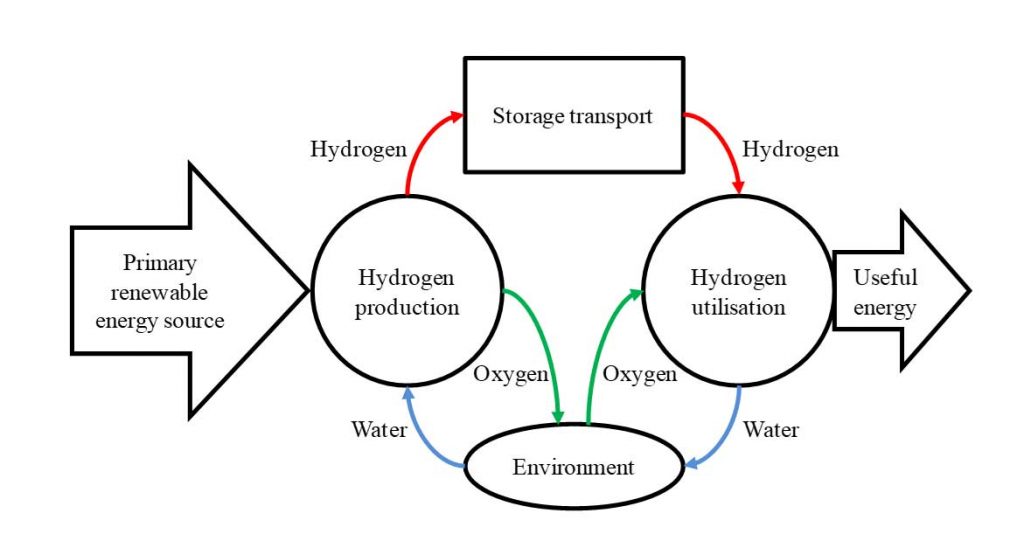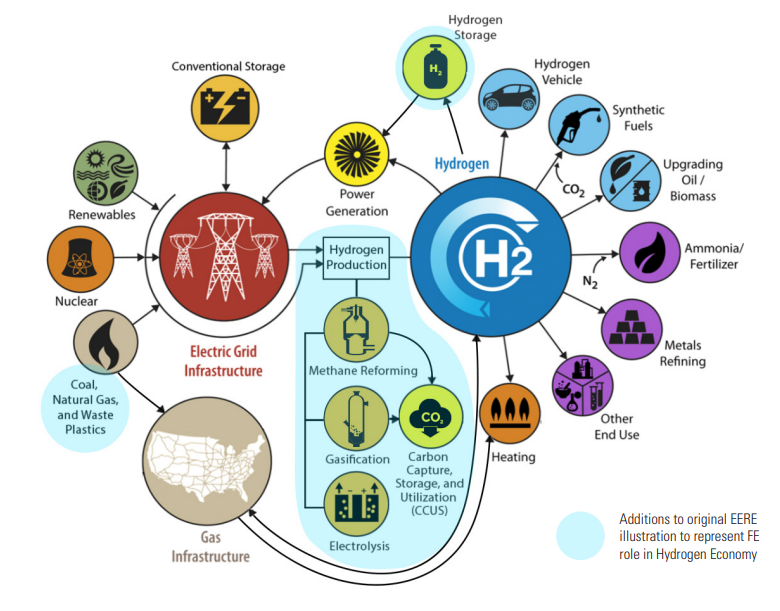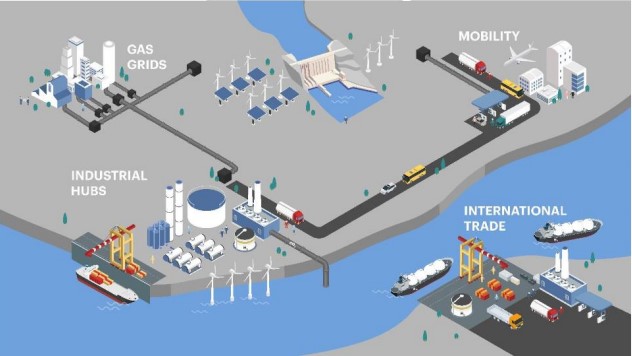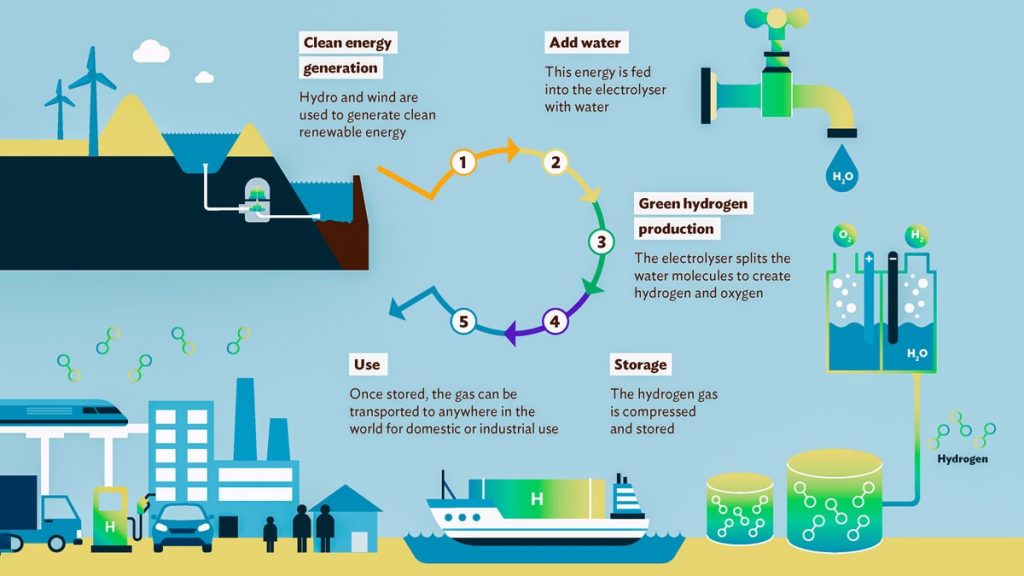IMPORTANCE OF HYDROGEN
Hydrogen can be used as a feedstock, a fuel or an energy carrier and storage, and has many possible applications across industry, transport, power and buildings sectors.
Most importantly, it does not emit CO2 and does not pollute the air when used. It is therefore an important part of the solution to meet the 2050 climate neutrality goal of the European Green Deal.
It can help to decarbonise industrial processes and economic sectors where reducing carbon emissions is both urgent and hard to achieve. Today, the amount of hydrogen used in the EU remains limited, and it is largely produced from fossil fuels. The aim of the strategy is to decarbonise hydrogen production - made possible by the rapid decline in the cost of renewable energy and acceleration of technology developments - and to expand its use in sectors where it can replace fossil fuels.
This diagram shows the life cycle of hydrogen when sourced from renewable energies. It also demonstrates that hydrogen is produced from water, which is used in conjunction with oxygen to generate useful energy such as electricity, giving water as a product.

ENERGY PERSPECTIVES
Hydrogen (H2) is the simplest element in the universe, and it only occurs naturally on Earth when combined with other elements. Hydrogen, like electricity, is an energy carrier (fuel) that can be used to store, move, and deliver energy produced from other sources. It can be produced without a carbon footprint from a variety of sources, including natural gas, coal, biomass, waste materials (i.e., plastics), or splitting water molecules. Gasification of fossil fuels with biomass and plastics is expected to be the lowest-cost route to providing carbon negative hydrogen when using carbon capture, utilization, and storage (CCUS) technologies.
Scientists have been interested in hydrogen as a source of energy since the 1800s,1 and it is currently an essential feedstock and fuel in many industries. Primary uses of hydrogen include the following applications: (1) as a chemical in ammonia (NH3 ) production (mainly for fertilizers), (2) as a chemical feedstock and catalyst, (3) as a hydrogenating agent for food and drug production, and (4) in petrochemical and refinery processing. Hydrogen consumed by large volume users is typically generated onsite (captive hydrogen), and for industries such as glass manufacture, food, and electronics, it is supplied by trailers (merchant hydrogen).
In addition, hydrogen is emerging as a low-carbon fuel option for transportation, electricity generation, and manufacturing applications, because it could decarbonize these three large sectors of the economy. Hydrogen has the highest energy content of any common fuel per unit of weight, but it is less dense than other fuels, which hinders its wide-scale deployment. While hydrogen fuel consumption is not widespread, there has been growing interest in its use as a potential fuel source across the economy. In fact, its use is projected to significantly increase in many countries through 2050 as these countries transition toward a low-carbon economy.
According to the International Energy Agency (IEA) report, Energy Technology Perspectives 2017, by 2050, fossil fuels will remain the primary source of hydrogen for the United States (~75%), Europe (~65%), and Japan (~85%). This forecast is based on the regional abundance of fossil fuels, the low cost of hydrogen production, and other benefits (e.g., reduced emissions) of sourcing hydrogen from fossil fuels with CCUS, rather than using it for power generation directly.
The lead Federal agency for energy R&D, DOE develops technologies to diversify and increase domestic energy supplies and make energy more affordable, improve domestic energy production and use, and enhance the security, reliability, and resilience of energy infrastructure. FE has a broad portfolio of R&D activities and is focused on technological advancements that could enable a transition toward a low-carbon economy with hydrogen. DOE is well positioned to accelerate this transition by developing technology solutions that enable the production of hydrogen from fossil fuels with neutral, or even negative, carbon emissions. FE’s depth of experience and R&D conducted over the past 30 years have been focused on fossil fuels. Future efforts can be summarized in four major R&D focus areas:
- Carbon-Neutral Hydrogen Production Using Gasification and Reforming Technologies
- Large-Scale Hydrogen Transport Infrastructure
- Large-Scale Onsite and Geological Hydrogen Storage
- Hydrogen Use for Electricity Generation, Fuels, and Manufacturing.
Beyond R&D, FE can also leverage past experience in hydrogen handling and licensing reviews for liquefied natural gas (LNG) export to support U.S. hydrogen export. For example, FE is well positioned to help develop safety and other requirements for hydrogen export facilities, which will be essential to materializing U.S. exports to global markets that are shifting to greater hydrogen use in electricity, manufacturing, transportation, or residential sectors.
For the past 20 years, FE—in partnership with industry—has pioneered the direct use of hydrogen for power generation.
The office’s sponsored research has resulted in the development of hydrogen combustion turbines for power generation and combustors that can replace the natural gas combustors in commercially available combustion turbines. Research is currently underway on technologies that can produce hydrogen from coal-derived synthesis gas and build and operate a zero-emissions, high-efficiency energy plant that coproduces hydrogen and electricity from coal, biomass, and waste.
Efforts to enable 100% hydrogen firing in utility-scale combustion turbines are also in progress.
FE and industry have the potential to leverage ongoing work and existing infrastructure to improve the economics of hydrogen production from natural gas via steam methane reforming (SMR) processa and coal/biomass/waste plastic gasification with CCUS to realize negative carbon dioxide (CO2 ) emissions. In addition, there is growing interest in conversion of natural gas to hydrogen and solid carbon, thereby providing an additional byproduct revenue stream.
Such innovations in the use of our abundant natural gas resources have the potential to strengthen existing and future Markets.

U.S. energy security, resiliency, and economic prosperity are enhanced through:
- Producing hydrogen from diverse domestic resources, including coal, biomass, natural gas, petroleum, petroleum products (e.g., waste plastics), and other recyclable materials with CCUS
- Gasifying blends of coal, biomass, waste plastics, and other recyclable materials with CCUS results in hydrogen produced with net-negative carbon emissions and other environmental benefits when CCUS is integrated with the gasifier
- Having hydrogen widely available for the chemicals and liquid fuels industries
- Using carbon-neutral hydrogen in transportation, stationary or remote power, and portable power applications using hydrogen turbines and fuel cell technologies
- Utilizing gas turbine assets for on-demand centralized and distributed power generation with near-zero emissions
- Supporting reliability and resiliency on the grid using simple-cycle or combined-cycle hydrogen turbines to enable grid stability and large-scale (e.g., gigawatt-hour) energy storage Increasing hydrogen storage and power generation supports intermittent renewable power generators where bulk electricity storage is not adequate to cover demand
- Providing large-scale energy storage capacity using hydrogen for both transportation and generation needs without the need to process and consume vast quantities of critical minerals required by electricity storage technologies (e.g., batteries)
- Allowing technologies like coal with CCUS and nuclear power to run in a steady-state mode and producing hydrogen for storage and use when the demand for electricity is low
- Supporting hydrogen-enabled innovations in domestic industries, thereby promoting manufacturing of advanced products.
Figure 2 provides an overview of hydrogen uses and national benefits and shows the relationship of FE’s R&D program elements to support a hydrogen economy in the United States.
Relationship of FE Program Elements to Comprehensive Hydrogen Strategy

Too see more: USDOE_FE_Hydrogen_Strategy_July2020.pdf
Hydrogen for a Clean Transition
Strategic Advantages of Hydrogen
- For Sector coupling – as a bridge between different types of energies
- For Storage – utilizing electrical energy that would otherwise have been lost
- For Storage – enabling use of massive quantities of renewable energy
- For Stability – balancing grid and buffering energy system
- For Decarbonization – as a building block of all electrofuels
- For Feedstock – using captured carbon
- For Certainty – avoiding CO2 capture from air


Opportunities for scaling up hydrogen to 2030
The reason for the growing momentum behind hydrogen is the insight that existing gas infrastructure can be used to transport hydrogen, with limited adjustments and costs in the gas grid in a transition phase. This significantly enhances the potential of hydrogen. Carbon emission savings would depend on the quantity of zero carbon hydrogen blended, and limits for this in countries vary.

